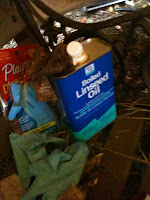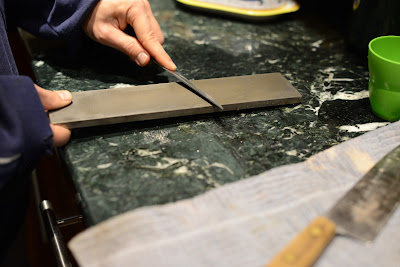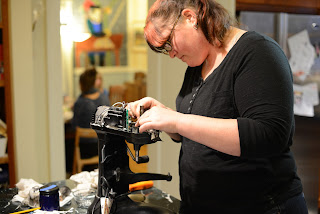Like most cheese makers, I have made Ricki Carroll's 30 minute mozzarella from my much beaten up volume of Home Cheesemaking. In fact, I may owe a bit of my belly fat to this recipe. It's so easy. Instead of acidifying the milk with a bacterial culture, which takes a good deal of time, you use citric acid, and "KAPOW" the milk is ready to turn into cheese. It's so rewarding, and the finished, stretchy cheese is radically different from milk. You get a real sense of process in a compressed time.
 On the down side, though, the thirty minute cheese is a bit on the overly stretchy side for me, and lacks some of the flavor notes you get from culturing milk. I like a very tender, sour tasting, delicate mozzarella, and, nudged by being in a challenge, I was finally willing to invest the significant amount of time needed to make it the old fashioned way.
On the down side, though, the thirty minute cheese is a bit on the overly stretchy side for me, and lacks some of the flavor notes you get from culturing milk. I like a very tender, sour tasting, delicate mozzarella, and, nudged by being in a challenge, I was finally willing to invest the significant amount of time needed to make it the old fashioned way.Because although this cheese only takes one day to make, it does take most of that day. It's similar to pet sitting a puppy - you don't need to be there all the time, but if you neglect it at crucial times you will be sorry. So this is not a cheese to make with your high school best friend, who is only in town for one day, and wants to get pedicures in the morning and see Anna Karenina in the afternoon and then make something home made for dinner. It's not a good cheese to make with the Webelos den who can't braid a piece of string without getting in a fight. This cheese it takes anywhere from 7 to 16 hours to make, and requires attention intermittently throughout.
 Recipe:
Recipe:
1 gallon milk
1/4 t thermo b starter culture
1/4 t calcium chloride diluted in 1/4 c dechlorinated water
3/4 t rennet in 1/4 c dechlorinated water
kosher salt
Cheese cloth
pH paper
Heat milk to 95 F (35 C) gently over 20 minutes. You will hold the milk at this temperature for the next two hours, so place the pot of milk in a sink full of warm water or devise some other water bath setup.
Add starter, mix well with a whisk for 20 strokes. Cover and ripen 45 minutes
Add calcium chloride, whisk in as above. Wait ten minutes, then whisk in rennet as above. Cover and leave for 1 hour, at which point it will be solidified curds in clear whey
Cut curds into 1/2" cubes, cutting first one way, then at 90 degrees to form squares, then angling the knife to reach the bottom of the pan, creating slanted diamond like cube thingies. Leave undisturbed for 30 minutes, during which time more whey will separate from the curds.
Gently raise the heat, so that the temperature goes up to 105 F (42 C) over a thirty minute period. Stir/agitate the cubes gently as you heat. Continue to gently stir/agitate for ten more minutes, then let the curds settle to the bottom of the pot for 30 minutes. They will start to clump together, and continue to do so in the next steps.
Dampen cheesecloth in the whey, and use it to line a colander. Place a pot under the colander to catch the whey, and pour the curds and whey into the colander. The curds will drain for the next fifteen minutes. Then transfer them back to the pot they were in.
Let the curds sit in the pot for the next 2 hours, turning occasionally. Keep them warm. They will lose a bit more whey, that's OK. They will form a blob, also fine.
At the 2 hour mark, test the pH. If it is above 5.2, wait 15 minutes and check again. Repeat as needed until it gets to 5.2 or below. This is the part where you just need to go with it. If you don't wait, the cheese won't be stretchy, and if you wait too long it will be like hideous white milky sour bubble gum. Just right, and you will have tender, malleable mozzarella.
Once you hit that sweet spot, reserve one quart of whey and heat the rest of the whey and 1 quart water on the stove to 170 - 180 F (around 80 C), which is TOO HOT TO PUT YOUR HANDS INTO. Just trust me on this.
Cut the curd mass into 1" cubes, and place them, or some of them, in a stainless steel bowl. Pour on the hot whey - carefully. Use a rubber spatula to work with the cubes in the hot liquid, moving them around to form a ball. Now put on clean rubber gloves, and lift the ball out in your hands. Stretch it into a rope, and double it back on itself. This part should be worth everything that went before!!!
You can return it to the hot whey if it starts to tense up on you. Stretch and fold it a couple of times, to give it texture and shape. Then quite because you will make it rubbery if you work it too much.
Shape it into balls, and place them in a bowl of ice water.
Make a brine of 3 quarts whey and 9 oz salt and cool it in an ice bath. Place the cooled cheese in this brine for 8 hours, turning the cheese occasionally. Remove from the brine and serve or store covered in water to which you add a small pinch of citric acid.
How the cheese turned out:
This cheese failed. |
| A bowl full of failure |

Instead of the tender, chewy, dreamy cheese I visualized, it broke apart into grainy morsels when I heated it. I double checked my pH - it was right at 5 with both testing strips, two different brands that both worked accurately on other substances.
I let the curds acidify another fifteen minutes and tried again, but results were the same.At that point the pH was below 4.9, and the curds tasted like sour yogurt.
I was using goats' milk, from my own goat who is in her 9th month of lactation. This would probably qualify as late lactation milk an may have been the problem. I know stage of lactation can change the cheesemaking process.
I was seized by a deep sense of discouragement, went to the hardware store and impulse shopped 25 feet of 1/4" soaker hose. When I got home, the kitchen smelled like hot whey and sour milk. I cleaned up and sat down to write.
 |
| Not really where my cheese ended up, just a reflection of my attitude toward it |
If nothing else, at least it won't end up in the trash. The hens never think I make mistakes. Sour curd is as good as any other in their book.
Shared on: Cheesepalooza































